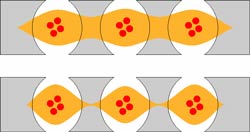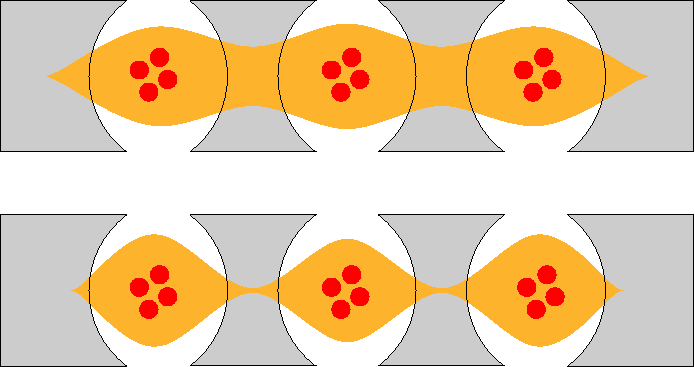Light Impersonates Electrons
Photons, the quantum particles of light, ordinarily pass through one another like ghosts, but they can sometimes affect each other through atom intermediaries. Now, in the 7 September Physical Review Letters, a team proposes a way to make such atom-induced interaction ten times stronger than ever thought possible. The scheme might allow researchers to make strange new kinds of matter made entirely of light and to use them in probing the physics of quantum liquids and solids more closely than ever before.
Physicists can store photons for relatively long times inside microscopic doughnuts of transparent silicon or other tiny structures. Linking up large numbers of such “cavities” and inducing their photons to interact could allow researchers to create systems of many photons, the particles acting somewhat like electrons in exotic solid states. Aside from their raw novelty, researchers hope to use them in probing the physics of high-temperature superconductors and other unusual materials.
To get photons to interact, theorists have proposed introducing extra atoms into the cavities. For example, a few atoms of a different element could be implanted into each silicon cavity. According to quantum theory, if these atoms are driven with laser light in the right way, they can induce a so-called photon blockade: whereas the cavity alone can hold any number of photons, the cavity-plus-atoms will accept only a single photon, repelling efforts to inject any further photons. Experimentalists have already demonstrated this effect in a single cavity. But in an array of cavities, photons would be able to hop from cavity to cavity, repelling one another, unable to sit in the same cavity with another photon. These photons would mimic electrons in the way they interact in some exotic solids.
To make earlier proposals work, theorists found that the photon energy had to be stored partly by the extra atoms and partly by the cavity. This messy “mixing” of the energy into the electronic states would make it hard for experimentalists to fine-tune the light sources to get strong photon interactions. But Michael Hartmann and Martin Plenio of Imperial College London have now found theoretically that the right choice of atomic states and laser intensity leaves the photon energy purely in the cavity and not in the atom’s electronic states. “This gives us more freedom,” Hartmann says, “to make use of the atom and its interaction with the photon.” As a result, the researchers calculate that the effective repulsion between photons can be made more than ten times larger than in previous proposals.
This repulsion is big enough, they suggest, to allow a “Mott insulator” state, in which the photons in different cavities would create a log-jam, each preventing its neighbors from hopping. Physicists have seen signs of such a frozen state in assemblies of trapped atoms and among electrons in solids. “But this would correspond to a crystal formed by light,” says Plenio.
Experimental realization of such a system may not be too far away. “My hope is within two to five years,” says Hartmann, although he says it’s hard to be sure.
In addition to exploring exotic new physics, a system of many strongly interacting photons might also be used to emulate virtually any quantum-mechanical solid or liquid, giving researchers an easier way to probe systems of many particles for which real experiments are difficult. Beyond such a “quantum simulator,” the trapped photons might provide technologies useful for quantum computing, such as sources of single photons. “But the excitement,” says Charles Tahan of Cambridge University in England, “comes from the ability to make what are essentially new forms of matter.”
–Mark Buchanan
Mark Buchanan is a freelance science writer who splits his time between Abergavenny, UK, and Notre Dame de Courson, France.





